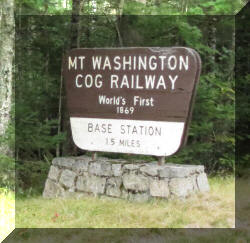
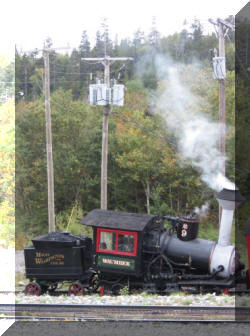
The Mount Washington COG Railway - New Hampshire - 2018
Updated: 05/09/19
The world's first mountain-climbing railway was invented and built by New Hampshire native, Sylvester Marsh. After nine years of planning and three years of construction, the railway opened on July 3, 1869. For the first forty years, wood-fired boilers powered the train to the 6,288 foot summit. Around 1910, coal was introduced as the fuel. The first biodiesel powered locomotive was dedicated on September 6, 2008.
Mary Lou was hoping we'd ride up pushed by the steam locomotive, but it only runs once a day - first run of the day.
The Marshfield Base Station
View on our way down to the Base Station . . .
On the grounds of the Base Station . . . After purchasing your tickets, you can look over the historic equipment on display, purchase a snack at the old trolley or sit and enjoy the activity and view.
Engine, engineer and water tower . . .
Track and cog . . .
The locomotives push the coaches up the mountain. There is a cog rail in the center of the tracks that allows the trains to go up steep grades. The passenger coaches have their own separate breaking system and can come down the mountain by themselves.
Cold Spring Hill is a 35% grade.
We saw this
when we arrived, adding to Mary Lou's excitement to ride on the steam locomotive
propelled coach. It was just parked on the siding to cool down. Being more
eco-friendly, the biodiesels make most of the trips up the mountain.
The Old . . . The New . . .
Coal-fired steam locomotives use one ton of coal plus 1,000 gallons of water on the ascent.
The biodiesel trains burn only 16-18 gallons of fuel per round trip.
We were "really" early - we watched this departure then, went into the base station to look around.
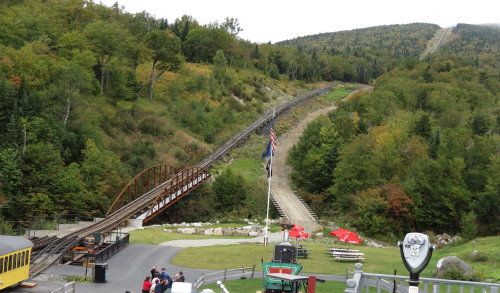
The Marshfield Base Station houses the ticket office, gift shop, restrooms, a quick-service restaurant and interactive museum.

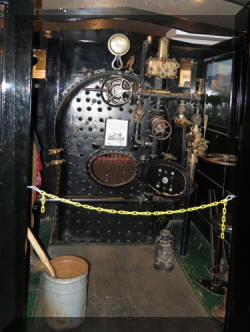 We
learned how the steam engine works at this display.
We
learned how the steam engine works at this display.
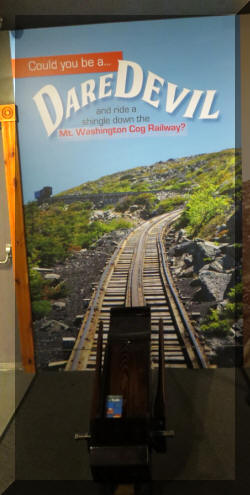
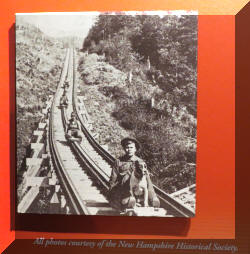 In the late 1800's, construction workers needed a quick way to get off the
mountain at the end of the day. Not wanting to hike down from their posts, some
at the top of the mountain, workers began to construct small carts (shingles) to
slide down the tracks.
In the late 1800's, construction workers needed a quick way to get off the
mountain at the end of the day. Not wanting to hike down from their posts, some
at the top of the mountain, workers began to construct small carts (shingles) to
slide down the tracks.
People who knew, said it took the average guy 15 minutes to slide the three miles of track from top to bottom, averaging 60 mph.
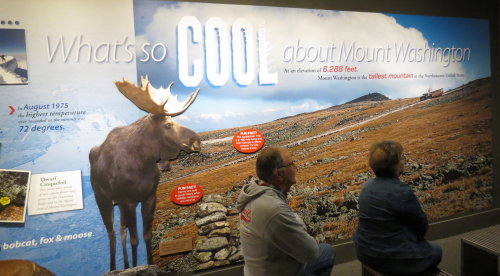
All Aboard, going up . . .
There are no assigned seats, first come - first seated. The staff did make accommodations for the handicapped gentleman that rode with us.
The conductor told us he had to keep his eyes on the track ahead because the
engineer in the engine behind the passenger car could not see the track. While
he was narrating the trip, he was checking the condition of the tracks.
The Waumbek Tank is for the steam engine to fill up it's 1,000 gallon water tank.
Notice the solar panels on the roof of this utility building.
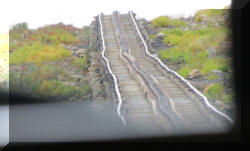 Jacob's Ladder, steepest grade at 37.41%, the front of the coach is about 14
feet higher than the rear.
Jacob's Ladder, steepest grade at 37.41%, the front of the coach is about 14
feet higher than the rear.
This moose
is always there to greet the visitors.
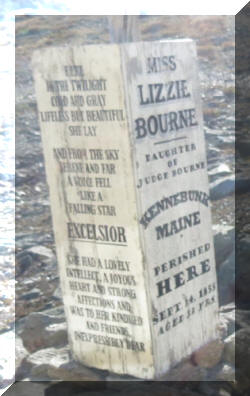 This monument marks the spot where a 23 year old hiker died on September 14,
1853 while attempting to climb Mt Washington.
This monument marks the spot where a 23 year old hiker died on September 14,
1853 while attempting to climb Mt Washington.
Map's show several marked hiking trails in the area of Mt. Washington, Mt. Clay, Mt. Adams and the Appalachian Trail.
Photographs from our trip up the mountain . . .
Holding
onto the side of the mountain . . .
The weather was clear at base camp, as we climber we got into the clouds . . . the conductor told us it was clear at the summit.
Above
the tree line, you can see part of the Appalachian foot trail, marked by
pyramidal piles of stones known as cairns.
And, we were indeed above the clouds also - it looked to Mary Lou like a "marshmallow world".
On a clear day the view covers four states, the province of Quebec, and the Atlantic Ocean - not today!
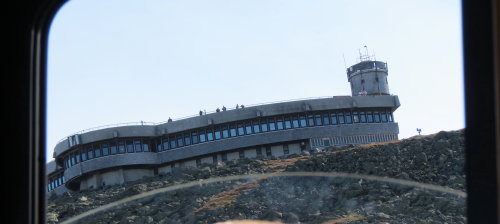
Sherman
Adams Summit Building and Mt. Washington Observatory Museum
The visitor's center is a year-round weather station operated by the nonprofit Mount Washington Observatory, In 1934, the station recorded a wind gust of 231 mph - the highest wind speed in the world ever observed by man.
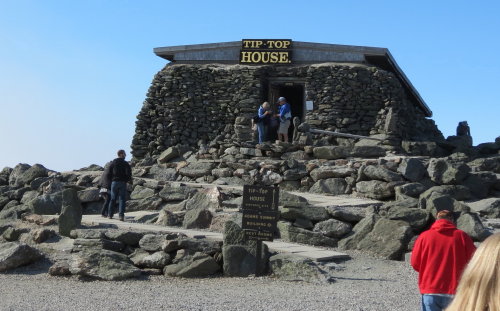 The
1853 stone Tip Top House is believed to be the oldest mountain top hostel in the
world. It is now a museum.
The
1853 stone Tip Top House is believed to be the oldest mountain top hostel in the
world. It is now a museum.
The Mt. Washington Auto Road was completed and opened to the public in 1861.
You can drive your own vehicle, starting at the base-area Toll House (some
restrictions apply), or take a guided tour beginning at the base lodge.
This building houses the weather museum, restrooms, snack counter, post office and gift shop.
All aboard - going down . . .
The conductor "flips" the seats before we load for the return trip to base station.
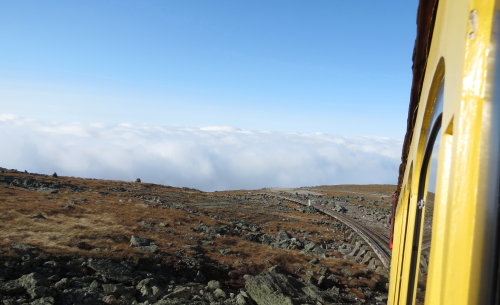
Looks like
we're driving off the edge of the mountain.
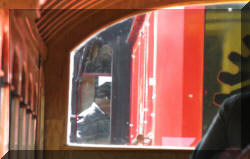 The
engineer through the windows . . .
The
engineer through the windows . . .
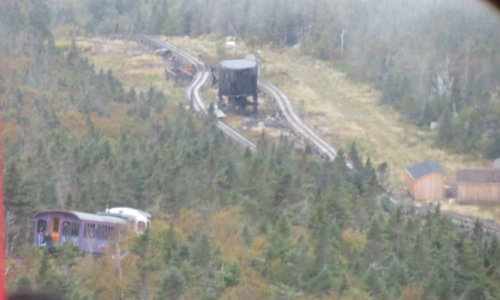 Weather on the mountain had changed, it was cloudy, drizzly and chilly.
Weather on the mountain had changed, it was cloudy, drizzly and chilly.
Heading home . . .
On
the way out of the COG Railway property, we stopped at a spot overlooking the
rail yard.
Coal and water . . .
Storage buildings and workshops . . .
A source of pride to the Cog Railway us that the new locomotives were designed and constructed on-site, in these workshops near Marshfield Station.
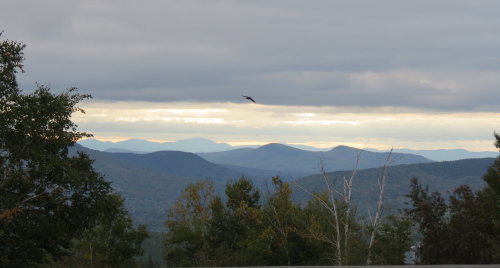 It
was getting dark as we headed back to the HitchHiker. Looking to our left, the
mountains looked photogenic.
It
was getting dark as we headed back to the HitchHiker. Looking to our left, the
mountains looked photogenic.
The Mount Washington Cog Railway tickets: adults $72, Seniors $68, Children age 4-12 $41 (slightly higher for steam engine). Round trip takes about 3 hours, including up to an hour on the summit.
For more information: www.thecog.com